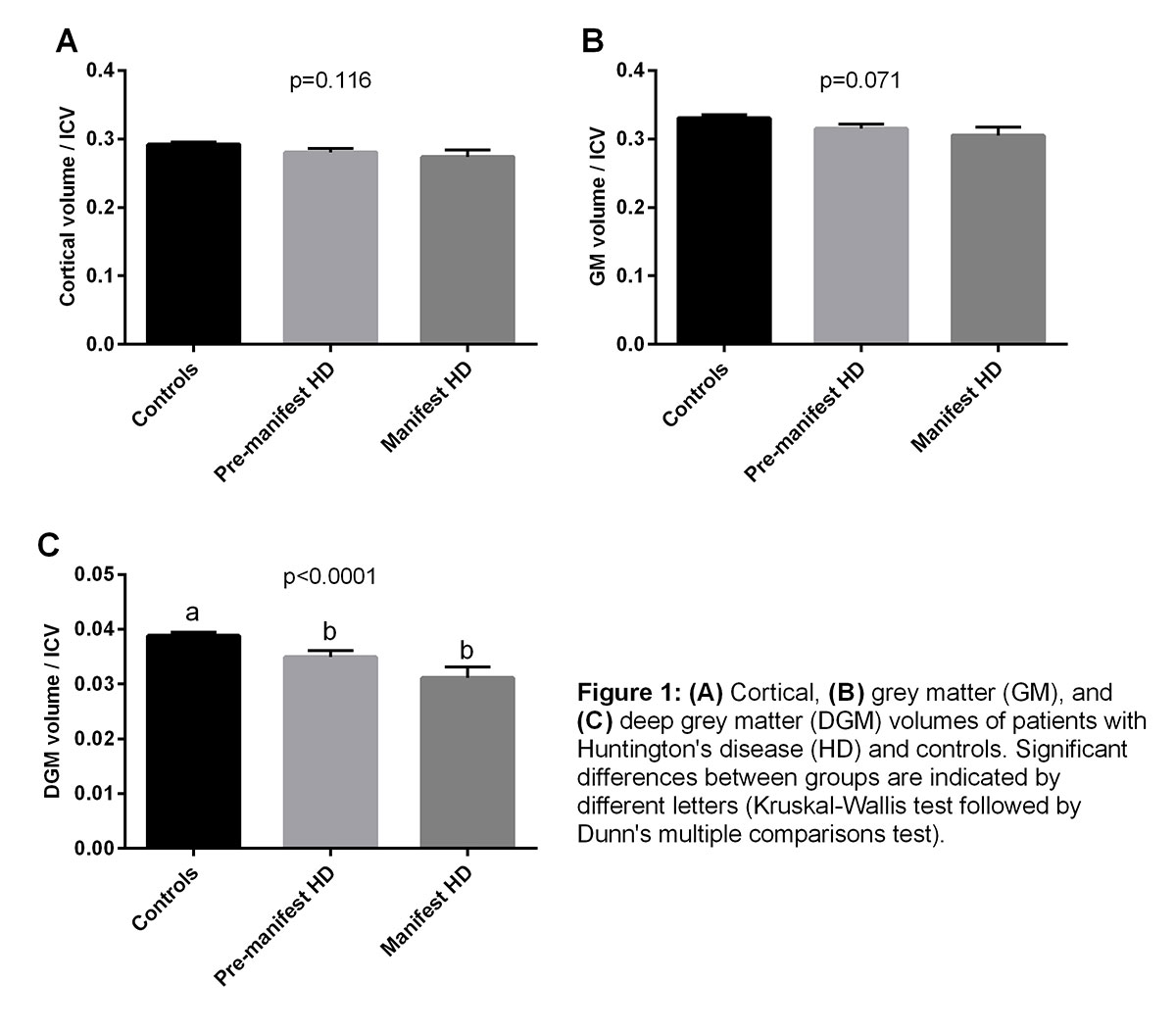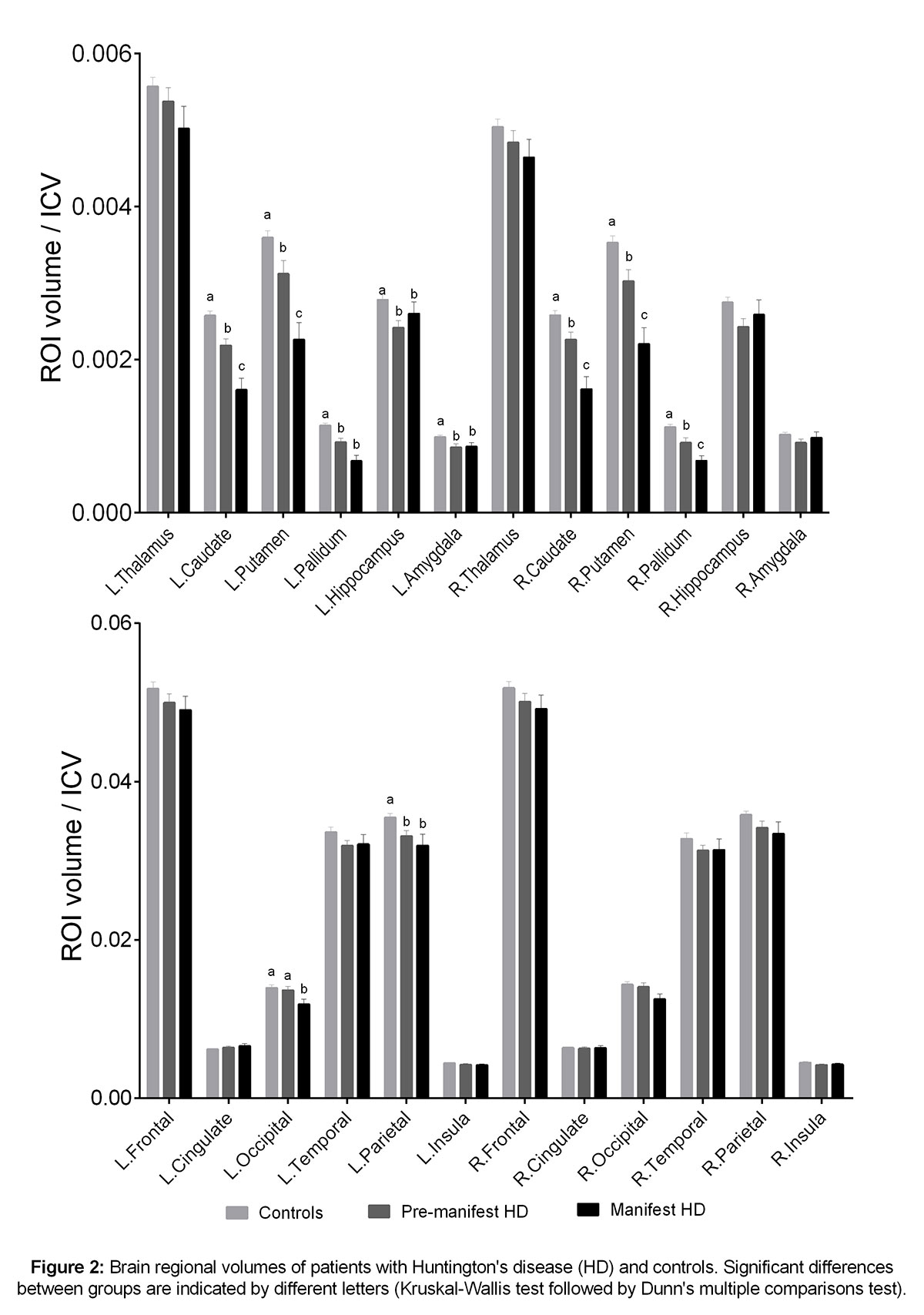Session Information
Date: Monday, September 23, 2019
Session Title: Huntington’s Disease
Session Time: 1:45pm-3:15pm
Location: Agora 3 West, Level 3
Objective: To determine whether brain regional volumes are associated with clinical symptoms in premanifest and manifest Huntington’s disease (HD).
Background: Striatal atrophy has been considered a remarkable biomarker in HD. Striatal volumes can predict HD motor onset, and striatal atrophy progresses throughout the manifest period. It is still unclear whether other subcortical and cortical regions also undergo atrophy in HD.
Method: 26 patients with genetic diagnosis of HD [13 premanifest HD gene carriers (44.9±11.8 yo; 5M/8F), 13 manifest patients (49.5±10.4; 9M/4F)] and 15 controls (48.5±11.3 yo; 5M/10F) underwent a brain MRI at 3T with 3D-MPRAGE for volumetric assessment. Segmentation of region of interest (ROIs) was performed using the Freesurfer v5.3.0. Symptoms were assessed using the Problem Behaviors Assessment (PBA), the Unified HD Rating Scale (UHDRS), the Symbol Digit Modalities Test (SDMT), the Verbal Fluency Test (VFT) and the Stroop interference test.
Results: Both premanifest HD gene carriers and patients with HD presented a significant decrease in deep gray matter (DGM) volumes in comparison with controls (Fig. 1). The volume decrease was significant in most subcortical ROIs (Fig. 2). The volume changes were observed in premanifest HD gene carriers with a mean of 10 years before the predicted clinical diagnosis of HD. Among premanifest gene carriers, a higher CAP score (CAG age product; a proxy for cumulative disease burden), was associated with worse atrophy in DGM, hippocampus, and putamen. Lower pallidum volume was associated with a worse score in PBA–irritability/aggression subscale. Atrophy in ROIs such as caudate and hippocampus was associated with worse cognitive performance, as evaluated by the SDMT and VFT. Regarding manifest patients with HD, atrophy in striatal regions was associated with worse motor symptoms. Lower volumes in other subcortical ROIs such as pallidum, hippocampus, and amygdala were associated with worse cognitive performance, as observed by the scores at the SDMT, VFT, and Stroop interference test.
Conclusion: Brain atrophy is an early event in HD and antedates motor symptoms. Brain atrophy in premanifest and manifest HD is not restricted to the striatum, being observed in other subcortical regions as hippocampus and amygdala. Decreased volumes in subcortical structures are associated with behavioral/cognitive symptoms in premanifest HD carries and with motor/cognitive symptoms in manifest patients with HD.
To cite this abstract in AMA style:
N. Rocha, L. Latham, O. Charron, G. Papadimitropoulos, G. Colpo, L. Freeman, E. Furr Stimming, A. Teixeira. Subcortical atrophy is an early event in Huntington’s disease [abstract]. Mov Disord. 2019; 34 (suppl 2). https://www.mdsabstracts.org/abstract/subcortical-atrophy-is-an-early-event-in-huntingtons-disease/. Accessed April 18, 2025.« Back to 2019 International Congress
MDS Abstracts - https://www.mdsabstracts.org/abstract/subcortical-atrophy-is-an-early-event-in-huntingtons-disease/


